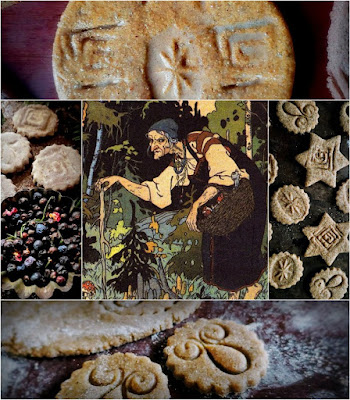A TOAST TO UKRAINIAN CHRISTMAS: WILD WINTER BERRY UZVAR
I shared this lovely healthy Uzvar recipe with my Gather patrons last year, but I’m
sharing it tonight in honor of Ukrainian Christmas and my beloved mother-in-law Rosie who passed away late November 2021. For the many, many years I’ve been married, I loved hearing her remembrances of this holiday, how the house was full of family, relatives, and neighbors, food and drink were plentiful, and women laughed and worked together in the kitchen preparing the traditional 12 course Christmas Feast! The table would be set with the best linens and dishes, before being laden with perogies, pickled herring, borscht, mushroom dumplings, cabbage rolls, braided bread, and more.
Rose was the ever-steady matriarch at the heart of our family and in the great Ukrainian Baba tradition, she expressed her love for her family with food. Her incomparable exquisite perogies were the tradition for Christmas Eve dinner. Rosie always wanted to celebrate the full-out old-fashioned Ukrainian Christmas that she remembered as a child. Sadly it just never happened. Orthodox Christian tradition still follows the old Julian Calendar which means Ukrainian Christmas falls on January 7th and by that time family members have long returned home after the holidays and gone back to work.
So tonight I share this post in tribute to Rosie and the old world food magic of Ukrainian Christmas. Within the Christian tradition, each course represents one of the twelve apostles but according to pre-Christian folklore (and popular memory), each course represents a month during the coming year. The feasting begins with the appearance of the first star in the evening sky and each food consumed has a meaning – honey for example is meant to represent the sweetness of life.
The libation of choice is Uzvar, one of the 12 most important dishes of the Sviata Vecheria (‘Holy Dinner’) and considered a Ukrainian “cure-all” for all that ails you. Uzvar is a decoction (a herbal term used to describe extracting the essence of a plant for medicinal purposes by slow brewing/boiling) made with dried fruits and berries together – and adding a touch of honey for sweetening.

Packed full of vitamins, minerals, and vital nutrients, it was traditionally consumed during the winter months when fresh fruit was not available. A big jug of Uzvar always accompanies the Christmas Eve feast and traditionally should contain twelve different fruits. I couldn’t manage the 12 fruits but I went with 12 ingredients!
Another important ritual dish is Kutia or Kutya, a wheat berry porridge/pudding which also contains honey, poppy seeds, and nuts. It symbolizes eternal life and prosperity and is often served with a lit candle to commemorate the family’s dead. A vegetarian version, bahata kutia, is prepared for Christmas Eve but on Orthodox New Year (also known Shchedriy Vechir, which means Bountiful or Generous Evening or “Melania’s Day” or “Melanky Day”) a “generous” version called schedra kutia is enriched with butter, milk, or cream, and often a splash of wine or cognac. YUM. (Gather Patrons – I’m currently experimenting with Kutia inspired cake recipe for Melanie Day /Ukrainian New Year. I think it’s going to be delightful!)

Eating this “generous” Kutia on New Year Day ensures health, wealth, and happiness for all the next year. Many other treats like dumplings, pancakes, cakes with curd, sweets, and honey-cakes were served, as it is believed that the more sweetness and variety on the table that day, the more generous and sweet the next year will be!
The ritual significance of Kutia and Uzvar is very ancient, Ukrainian ethnographer Fedir Vovk suggests their origins stretch back to the Neolithic era! Many Ukrainian Christmas customs have strong pagan roots. According to the amazing cookbook, Festive Ukrainian Cooking“ the Christmas table was strewn with hay, a symbol of fertility and abundant harvest, then covered with a cloth. A sheaf of wheat, a symbol of abundance and nature itself, graced the corner of the room. This wheat was often ceremonially gathered during autumn harvest rituals and symbolized the household’s wish for a bountiful harvest for the upcoming year.
 Recipes for Uzvar vary wildly, apples, pears, prunes, apricots, raisins, currants are often used as are wild fruits such as rosehips, hawthorn berries, bilberries (cranberry), and blackthorn. For this version of Uzvar, I went with dried hawthorn berries, a variety of different dried rosehips, oregon grape berries, wild cranberries, and huckleberries. You don’t need these exact ingredients – you can use whatever berries or fruits you have on hand, some recipes also include fresh berries. You should be able to purchase rosehips or hawthorn berries from your local herb store. You could also use fresh foraged hawthorn berries or rosehips if you can’t find dried.
Recipes for Uzvar vary wildly, apples, pears, prunes, apricots, raisins, currants are often used as are wild fruits such as rosehips, hawthorn berries, bilberries (cranberry), and blackthorn. For this version of Uzvar, I went with dried hawthorn berries, a variety of different dried rosehips, oregon grape berries, wild cranberries, and huckleberries. You don’t need these exact ingredients – you can use whatever berries or fruits you have on hand, some recipes also include fresh berries. You should be able to purchase rosehips or hawthorn berries from your local herb store. You could also use fresh foraged hawthorn berries or rosehips if you can’t find dried.

It is traditionally served chilled, although it can also be served warm. Often on Christmas Eve, it is served as a dessert. You simply add the compote of softened fruit to a glass, douse with Uzvar, then top off with a sprinkle of sugar. ( You wouldn’t want to do this with this wild berry version of Uzvar as the hawthorn berries have pits and whole rose hips contain very irritating hairs – so keep this in mind when concocting your Uzvar!)
https://gathervictoria.com/2022/01/06/a-toast-to-ukrainian-christmas-wild-winter-berry-uzvar/


Комментарии
Отправить комментарий